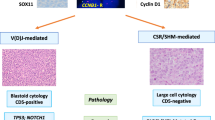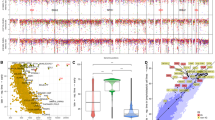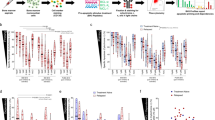Abstract
Ocular adnexal marginal zone B-cell lymphomas (OAMZLs) arise in the connective tissues of the orbit or in the mucosa-associated lymphoid tissue of the conjunctiva. Here, we present the immunological and genetic analyses of 20 primary Chlamydia psittaci (Cp)-negative OAMZLs. Analysis of the immunoglobulin variable heavy chain (IgVH) gene usage demonstrated a significant preference for VH4-34. A combined analysis across all previously published OAMZLs confirmed that this is a general feature of OAMZL, in particular of the Cp-negative group. Our series of OAMZLs did not express the characteristic rheumatoid factor VHDJH rearrangements that were previously found in salivary gland- and gastric-marginal zone B-cell lymphomas (MZBCLs). We did not detect the MZBCL-specific chromosomal translocations, t(11;18) API2-MALT1 (mucosa-associated lymphoid tissue1) and t(14;18) IgH/MALT1. Two cases contained a premature stop codon in the A20 gene (TNFAIP3) and one case harbored the activating MYD88 hotspot mutation L265P. Variable nuclear expression of BCL10, NFκB1 (p50) and NFκB2 (p52) suggests that other additional genetic abnormalities affecting the NFκB pathway exist within this group of lymphomas. OAMZL showed variable expression of the chemokine receptor CXCR3 and integrin α4β7 by the tumor B cells, and low interferon-γ and interlukin-4 mRNA levels in the tissue, indicative of an inflammatory environment with features in between those previously found in cutaneous and other extranodal MZBCL. The strongly biased usage of VH4-34 in Cp-negative OAMZLs suggests involvement of a particular stimulatory (auto-) antigen in their development.
This is a preview of subscription content, access via your institution
Access options
Subscribe to this journal
Receive 12 print issues and online access
$259.00 per year
only $21.58 per issue
Buy this article
- Purchase on SpringerLink
- Instant access to full article PDF
Prices may be subject to local taxes which are calculated during checkout



Similar content being viewed by others
References
Bende RJ, van Maldegem F, van Noesel CJ . Chronic inflammatory disease, lymphoid tissue neogenesis and extranodal marginal zone B-cell lymphomas. Haematologica 2009; 94: 1109–1123.
Bende RJ, Aarts WM, de Jong D, Pals ST, van Noesel CJ . Among B-cell non-Hodgkin's lymphomas, MALT lymphomas express a unique antibody repertoire with frequent rheumatoid factor reactivity. J Exp Med 2005; 201: 1229–1241.
Hoogeboom R, Bende RJ, van Noesel CJ . MALT lymphoma-derived rheumatoid factors are nonpolyreactive high-affinity antibodies. Blood 2010; 116: 1818–1819.
Wotherspoon AC . Regression of primary low-grade B-cell gastric lymphoma of mucosa-associated lymphoid tissue type after eradication of Helicobacter pylori. Lancet 1993; 342: 575.
van Maldegem F, van Dijk R, Wormhoudt TA, Kluin PM, Willemze R, Cerroni L et al. The majority of cutaneous marginal zone B cell lymphomas express class switched immunoglobulins and develop in a T helper type 2 inflammatory environment. Blood 2008; 112: 3355–3361.
Beima KM, Miazgowicz MM, Lewis MD, Yan PS, Huang TH, Weinmann AS . T-bet binding to newly identified target gene promoters is cell type-independent but results in variable context-dependent functional effects. J Biol Chem 2006; 281: 11992–12000.
Chanudet E, Ye H, Ferry J, Bacon C, Adam P, Muller-Hermelink H et al. A20 deletion is associated with copy number gain at the TNFA/B/C locus and occurs preferentially in translocation-negative MALT lymphoma of the ocular adnexa and salivary glands. J Pathol 2008; 217: 420–430.
Zhou Y, Ye H, Martin-Subero JI, Gesk S, Hamoudi R, Lu YJ et al. The pattern of genomic gains in salivary gland MALT lymphomas. Haematologica 2007; 92: 921–927.
Honma K, Tsuzuki S, Nakagawa M, Karnan S, Aizawa Y, Kim WS et al. TNFAIP3 is the target gene of chromosome band 6q23.3–q24.1 loss in ocular adnexal marginal zone B cell lymphoma. Genes Chromosomes Cancer 2008; 47: 1–7.
Novak U, Rinaldi A, Kwee I, Nandula SV, Rancoita PM, Compagno M et al. The NF-{kappa}B negative regulator TNFAIP3 (A20) is inactivated by somatic mutations and genomic deletions in marginal zone lymphomas. Blood 2009; 113: 4918–4921.
Kato M, Sanada M, Kato I, Sato Y, Takita J, Takeuchi K et al. Frequent inactivation of A20 in B-cell lymphomas. Nature 2009; 459: 712–716.
Ngo VN, Young RM, Schmitz R, Jhavar S, Xiao W, Lim KH et al. Oncogenically active MYD88 mutations in human lymphoma. Nature 2011; 470: 115–119.
Ferreri AJ, Guidoboni M, Ponzoni M, De Conciliis C, Dell’Oro S, Fleischhauer K et al. Evidence for an association between Chlamydia psittaci and ocular adnexal lymphomas. J Natl Cancer Inst 2004; 96: 586–594.
Yoo C, Ryu MH, Huh J, Park JH, Kang HJ, Ahn HS et al. Chlamydia psittaci infection and clinicopathologic analysis of ocular adnexal lymphomas in Korea. Am J Hematol 2007; 82: 821–823.
Chanudet E, Zhou Y, Bacon CM, Wotherspoon AC, Muller-Hermelink HK, Adam P et al. Chlamydia psittaci is variably associated with ocular adnexal MALT lymphoma in different geographical regions. J Pathol 2006; 209: 344–351.
Aigelsreiter A, Leitner E, Deutsch AJ, Kessler HH, Stelzl E, Beham-Schmid C et al. Chlamydia psittaci in MALT lymphomas of ocular adnexals: the Austrian experience. Leuk Res 2008; 32: 1292–1294.
Mulder MM, Heddema ER, Pannekoek Y, Faridpooya K, Oud ME, Schilder-Tol E et al. No evidence for an association of ocular adnexal lymphoma with Chlamydia psittaci in a cohort of patients from the Netherlands. Leuk Res 2006; 30: 1305–1307.
Bahler DW, Szankasi P, Kulkarni S, Tubbs RR, Cook JR, Swerdlow SH . Use of similar immunoglobulin VH gene segments by MALT lymphomas of the ocular adnexa. Mod Pathol 2009; 22: 833–838.
Daibata M, Nemoto Y, Togitani K, Fukushima A, Ueno H, Ouchi K et al. Absence of Chlamydia psittaci in ocular adnexal lymphoma from Japanese patients. Br J Haematol 2006; 132: 651–652.
Yakushijin Y, Kodama T, Takaoka I, Tanimoto K, Bessho H, Sakai I et al. Absence of chlamydial infection in Japanese patients with ocular adnexal lymphoma of mucosa-associated lymphoid tissue. Int J Hematol 2007; 85: 223–230.
Rosado MF, Byrne Jr GE, Ding F, Fields KA, Ruiz P, Dubovy SR et al. Ocular adnexal lymphoma: a clinicopathologic study of a large cohort of patients with no evidence for an association with Chlamydia psittaci. Blood 2006; 107: 467–472.
Coupland SE, Foss HD, Anagnostopoulos I, Hummel M, Stein H . Immunoglobulin VH gene expression among extranodal marginal zone B-cell lymphomas of the ocular adnexa. Invest Ophthalmol Vis Sci 1999; 40: 555–562.
Hara Y, Nakamura N, Kuze T, Hashimoto Y, Sasaki Y, Shirakawa A et al. Immunoglobulin heavy chain gene analysis of ocular adnexal extranodal marginal zone B-cell lymphoma. Invest Ophthalmol Vis Sci 2001; 42: 2450–2457.
Mannami T, Yoshino T, Oshima K, Takase S, Kondo E, Ohara N et al. Clinical, histopathological, and immunogenetic analysis of ocular adnexal lymphoproliferative disorders: characterization of malt lymphoma and reactive lymphoid hyperplasia. Mod Pathol 2001; 14: 641–649.
Adam P, Haralambieva E, Hartmann M, Mao Z, Ott G, Rosenwald A . Rare occurrence of IgVH gene translocations and restricted IgVH gene repertoire in ocular MALT-type lymphoma. Haematologica 2008; 93: 319–320.
Dagklis A, Ponzoni M, Govi S, Cangi MG, Pasini E, Charlotte F et al. Immunoglobulin gene repertoire in ocular adnexal lymphomas: hints on the nature of the antigenic stimulation. Leukemia 2011; e-pub ahead of print 25 October 2011; doi: 10.1038/leu.2011.276.
Jaffe E, Harris NL, Stein H, Vardiman JW . Pathology and Genetics of Tumours of Haematopoietics and Lymphoid Tissues. IARC Press: Lyon, 2001.
Heddema ER, Beld MG, de Wever B, Langerak AA, Pannekoek Y, Duim B . Development of an internally controlled real-time PCR assay for detection of Chlamydophila psittaci in the LightCycler 2.0 system. Clin Microbiol Infect 2006; 12: 571–575.
Aarts WM, Willemze R, Bende RJ, Meijer CJLM, Pals ST, van Noesel CJM . VH gene analysis of primary cutaneous B-cell lymphomas: evidence for ongoing somatic hypermutation and isotype switching. Blood 1998; 92: 3857–3864.
Cook GP, Tomlinson IM . The human immunoglobulin VH repertoire. Immunol Today 1995; 16: 237–242.
Brochet X, Lefranc MP, Giudicelli V . IMGT/V-QUEST: the highly customized and integrated system for IG and TR standardized V–J and V–D–J sequence analysis. Nucleic Acids Res 2008; 36 (Web Server issue): W503–W508.
Lazarovits AI, Mosciki RA, Kurnick JT, Camerini D, Bhan AK, Baird LG et al. Lymphocyte activation antigens: a monoclonal antibody, anti-Act-1 defines a new late lymphocyte activation antigen. J Immunol 1984; 133: 1857–1862.
Haralambieva E, Adam P, Ventura R, Katzenberger T, Kalla J, Holler S et al. Genetic rearrangement of FOXP1 is predominantly detected in a subset of diffuse large B-cell lymphomas with extranodal presentation. Leukemia 2006; 20: 1300–1303.
Lenz G, Davis RE, Ngo VN, Lam L, George TC, Wright GW et al. Oncogenic CARD11 mutations in human diffuse large B cell lymphoma. Science 2008; 319: 1676–1679.
Chang B, Casali P . The CDR1 sequences of a major proportion of human germline Ig VH genes are inherently susceptible to amino acid replacement. Immunol Today 1994; 15: 367–373.
Klein U, Rajewsky K, Küppers R . Human immunoglobulin (Ig)M+IgD+ peripheral blood B cells expressing the CD27 cell surface antigen carry somatically mutated variable region genes: CD27 as a general marker for somatically mutated (memory) B cells. J Exp Med 1998; 188: 1679–1689.
Koelsch K, Zheng NY, Zhang Q, Duty A, Helms C, Mathias MD et al. Mature B cells class switched to IgD are autoreactive in healthy individuals. J Clin Invest 2007; 117: 1558–1565.
Tian C, Luskin GK, Dischert KM, Higginbotham JN, Shepherd BE, Crowe Jr JE . Evidence for preferential Ig gene usage and differential TdT and exonuclease activities in human naive and memory B cells. Mol Immunol 2007; 44: 2173–2183.
Tsuiji M, Yurasov S, Velinzon K, Thomas S, Nussenzweig MC, Wardemann H . A checkpoint for autoreactivity in human IgM+ memory B cell development. J Exp Med 2006; 203: 393–400.
Tiller T, Tsuiji M, Yurasov S, Velinzon K, Nussenzweig MC, Wardemann H . Autoreactivity in human IgG+ memory B cells. Immunity 2007; 26: 205–213.
Isnardi I, Ng YS, Srdanovic I, Motaghedi R, Rudchenko S, von Bernuth H et al. IRAK-4- and MyD88-dependent pathways are essential for the removal of developing autoreactive B cells in humans. Immunity 2008; 29: 746–757.
Wardemann H, Yurasov S, Schaefer A, Young JW, Meffre E, Nussenzweig MC . Predominant autoantibody production by early human B cell precursors. Science 2003; 301: 1374–1377.
Wu YC, Kipling D, Leong HS, Martin V, Ademokun AA, Dunn-Walters DK . High-throughput immunoglobulin repertoire analysis distinguishes between human IgM memory and switched memory B-cell populations. Blood 2010; 116: 1070–1078.
Silberstein LE, Jefferies LC, Goldman J, Friedman DF, Moore JS, Nowell PC et al. Variable region gene analysis of pathologic human autoantibodies to the related i and I red blood cell antigens. Blood 1991; 78: 2372–2386.
Li Y, Spellerberg MB, Stevenson FK, Capra JD, Potter KN . The I binding specificity of human VH 4-34 (VH 4–21) encoded antibodies is determined by both VH framework region 1 and complementarity determining region 3. J Mol Biol 1996; 256: 577–589.
Cappione AJ, Pugh-Bernard AE, Anolik JH, Sanz I . Lupus IgG VH4.34 antibodies bind to a 220-kDa glycoform of CD45/B220 on the surface of human B lymphocytes. J Immunol 2004; 172: 4298–4307.
Maemura K, Fukuda M . Poly-N-acetyllactosaminyl O-glycans attached to leukosialin. The presence of sialyl Le(x) structures in O-glycans. J Biol Chem 1992; 267: 24379–24386.
Bende RJ, Smit LA, Bossenbroek JG, Aarts WM, Spaargaren M, de Leval L et al. Primary follicular lymphoma of the small intestine: alpha4beta7 expression and immunoglobulin configuration suggest an origin from local antigen-experienced B cells. Am J Pathol 2003; 162: 105–113.
Drillenburg P, van der Voort R, Koopman G, Dragosics B, van Krieken JHJM, Kluin PhM et al. Preferential expression of the mucosal homing receptor integrin α4β7 in gastrointestinal non-Hodgkin's lymphomas. Am J Pathol 1996; 150: 919–927.
Compagno M, Lim WK, Grunn A, Nandula SV, Brahmachary M, Shen Q et al. Mutations of multiple genes cause deregulation of NF-kappaB in diffuse large B-cell lymphoma. Nature 2009; 459: 717–721.
Honma K, Tsuzuki S, Nakagawa M, Tagawa H, Nakamura S, Morishima Y et al. TNFAIP3/A20 functions as a novel tumor suppressor gene in several subtypes of non-Hodgkin lymphomas. Blood 2009; 114: 2467–2475.
Schmitz R, Hansmann ML, Bohle V, Martin-Subero JI, Hartmann S, Mechtersheimer G et al. TNFAIP3 (A20) is a tumor suppressor gene in Hodgkin lymphoma and primary mediastinal B cell lymphoma. J Exp Med 2009; 206: 981–989.
Acknowledgements
We thank Dr C Visser from the Department of Medical Microbiology at the AMC for the Cp diagnostics, R Hoogeboom from the Department of Pathology at the AMC for stimulating discussions and Drs YC Wu and DK Dunn-Walters from the Department of Immunobiology, King's College London School of Medicine, London, UK for their data set of germline IgVH genes of normal B-cell subpopulations.
Author information
Authors and Affiliations
Corresponding author
Ethics declarations
Competing interests
The authors declare no conflict of interest.
Additional information
Supplementary Information accompanies the paper on the Leukemia website
Supplementary information
Rights and permissions
About this article
Cite this article
van Maldegem, F., Wormhoudt, T., Mulder, M. et al. Chlamydia psittaci-negative ocular adnexal marginal zone B-cell lymphomas have biased VH4-34 immunoglobulin gene expression and proliferate in a distinct inflammatory environment. Leukemia 26, 1647–1653 (2012). https://doi.org/10.1038/leu.2012.28
Received:
Revised:
Accepted:
Published:
Issue date:
DOI: https://doi.org/10.1038/leu.2012.28
Keywords
This article is cited by
-
Novel developments in the pathogenesis and diagnosis of extranodal marginal zone lymphoma
Journal of Hematopathology (2017)
-
Persistierende herdförmige Bindehautläsion
Der Ophthalmologe (2016)
-
Clinical Aspects of Malt Lymphomas
Current Hematologic Malignancy Reports (2014)



